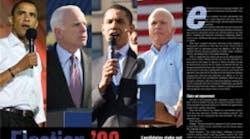Every four years, the presidential election campaign unfolds, and the position of the candidates on education is predictable: They are in favor of it.
Something else is easy to predict: In every presidential campaign, hot-button issues — some important and some infuriatingly not — suck up most of the oxygen, and the hoped-for focus on education withers and dies.
In 2008, Republican nominee John McCain and Democratic nominee Barack Obama have laid out their positions for improving America's education system; but with the nation at war, fuel prices climbing and financial institutions collapsing, subjects such as early-childhood education or charter schools don't seem as urgent.
That hasn't stopped education advocates from working to bring greater attention to what they see as the critical need to improve the U.S. education system (see sidebar, p. 20). But it's unlikely that the education platforms of either major candidate will be a deciding factor in November balloting.
Still, it's important for school and university administrators to be aware of how Obama and McCain view the education system and how they hope to improve it. Before President George W. Bush led the push for the No Child Left Behind (NCLB) Act, the generalization had been that Democrats favor more federal involvement in education and Republicans back a more hands-off approach. Now that the NCLB reform law has fallen into disfavor among many educators and politicians (see sidebar at end), the proposals of this year's presidential candidates reflect the previous party orthodoxy. McCain's education platform contains few specific proposals and more statement of philosophy, specifically about giving parents more choices; Obama's campaign proposes more programs and explains them in more detail.
Choice and empowerment
McCain, in his education policy statement, asserts that his plan “removes needless bureaucracy, empowers parents, teachers and principals, and ensures that every child has the opportunity to gain from a quality education.”
“John McCain believes our schools can and should compete to be the most innovative, flexible and student-centered — not safe havens for the uninspired and unaccountable,” his policy statement says.
Some specifics:
-
Choice
“Parents should be empowered with school choice to send their children to the school that can best educate them,” the campaign asserts.
-
Better teachers
“The single biggest challenge in turning around a failing school is getting quality teachers into that school,” the campaign states. To attract and develop high-quality teachers, McCain would encourage alternative certification programs; provide bonuses for teachers who work in underperforming schools; and provide funding for teacher development “to perform in today's technology-driven environment.”
-
Empowered principals
McCain wants principals to be given greater control over their school budgets. “The money must be controlled by the leader we hold accountable: the school principal with a single criterion — to raise student achievement.”
-
Expand the voucher program in Washington, D.C.
The program provides funds that enable about 1,900 students in the nation's capital to attend private schools. McCain would increase the $13 million-a-year funding to $20 million, which he says would benefit about 1,000 additional students.
-
Tutors
Students struggling to meet their state standards would be given immediate access to high-quality tutoring programs, certified either by a local district or by the federal government.
-
Online programs
McCain wants to spend $500 million to create new virtual schools and support the development of online courses. He also would allocate $250 million for grants that states would use to create virtual math and science academies.
In higher education, McCain calls for more innovation and a removal of regulatory barriers. He says he would simplify tax benefits as well as federal financial-aid programs. “Consolidating programs will help simplify the administration of these programs and help more students have a better understanding of their eligibility for aid,” the education policy statement says.
McCain also calls for making it easier for students and their families to get more information about schools and higher education. “Making this information available to families in a clear and concise manner will help more students make more informed choices about higher education,” the campaign says.
In early-childhood education, McCain seeks improvements in the Head Start program. Many Head Start centers, he believes, “have fallen prey to the same institutional flaws that have undermined the larger public education system — they lack quality instructors; they lack accountability to parents; and they are focused on process, not outcomes.”
The Republican wants to identify at least one successful Head Start program in every state and designate these as Centers for Excellence in Head Start. They would receive federal funding to expand their programs and disseminate their best practices to other Head Start programs.
The McCain campaign also calls for early-education programs to adhere to “meaningful, measurable standards designed to determine that students are ready for school.”
Focusing on what works
Obama's campaign estimates that his proposals for early education and K-12 schools would cost about $18 billion, and he hopes to pay for the changes by cutting wasteful federal spending. The Democratic candidate says he wants to identify programs that work and replicate them.
“We're not going to solve our education problems just by throwing money at them,” the policy states. “We have to make smart investments in innovating long-term solutions and developing a deep knowledge of what works.”
Some specifics:
-
Teachers
Obama seeks to improve schools' efforts in recruiting, preparing, retaining and rewarding teachers. The efforts would include more scholarships to help attract and train teachers; improvements in teacher education; mentoring for beginning teachers; incentives for schools that enable teachers to have shared planning time and collaborate with their colleagues; and salary incentives “for demonstrated knowledge, skill and expertise.”
-
Principals
The Democratic candidate wants to establish state leadership academies “to enable principals to develop the sophisticated skills they need.” Obama also would provide states with funds to provide principals with ongoing professional development training.
-
Math and science
Obama would make those two subjects a national priority. His proposed teacher scholarship program would place a priority on those with degrees in math, science or technology. He also would seek to improve the assessments used to evaluate the academic performance of students in science. “Science assessments need to do more than test facts and skills,” the campaign says. “They need to use a range of measures to test inquiry and higher-order thinking skills.”
-
At-risk students
Obama plans to create a $200 million grant program to support states and local districts that want to lengthen the school day or school year to provide more learning time for struggling students. He wants to provide federal support to improve education at the middle school level, including programs that identify early on who might be likely to drop out in later years. Obama also supports continuing federal efforts to help schools redesign the way they operate — initiatives such as small learning communities.
-
Research and development
Obama would seek to boost what he describes as the inadequate amount spent on researching and developing more effective educational tools and methods. “Part of this investment will involve an R&D program for improving science education,” the campaign says.
In higher education, Obama's platform focuses on making college more affordable. He wants to simplify a financial-aid application process and create an “American Opportunity Tax Credit” that will “ensure that the first $4,000 of a college education is completely free for most Americans.” He also wants to increase the amount that low-income students can receive in Pell Grants.
The Democratic candidate also would establish a program to help 11th-graders assess whether they are on track to be ready for college when they finish high school. Obama also seeks to boost the quality of community colleges with grants that would help institutions identify the types of skills and technical education that are in demand so they can establish new associate degree programs to address those needs.
In early-childhood education, Obama has proposed spending $10 billion on programs to educate children from age 0 to 5. He would create Early Learning Challenge Grants for states to establish programs for pregnant women and children younger than 5. He would expand the Early Head Start program, which serves children 3 years old and younger.
“The ‘zero to five’ plan will provide a coordinated strategy to the early education and care of children,” the Obama platform says.
Sidebar: A share of the spotlight
People paying attention to the 2008 presidential campaign are more likely to be familiar with squabbles over pigs and lipstick and bridges to nowhere than they are with the candidates' positions on education.
In politics, the trivial and titillating often divert focus away from important issues. Many education advocates have been frustrated watching campaigns that show little interest in what they believe is a critical national concern: improving the U.S. education system.
Some of those education advocates, with funding from the Bill & Melinda Gates Foundation and the Eli and Edythe Broad Foundation, have created a nonpartisan organization, Strong American Schools. Its “Ed in 08” campaign seeks to make education a top priority in the 2008 presidential election.
“The world is changing, jobs are evolving, and far too many students are simply not being prepared to be successful adults,” the group says.
A report the group released in September, “Diploma to Nowhere,” found that as many as 1 million students enrolling in college fail placement exams. The cost for colleges to provide remediation to those students exceeds $2 billion.
“In many ways, the problem is the American high school,” the report says. “It profoundly fails to prepare students for postsecondary work. A high school degree no longer demonstrates that a graduate is ready for college. Students' inadequate preparation for higher education has become a deep and widespread problem.”
Ed in 08 is focused on three priorities that it believes hold great promise for improving education: agreeing on American education standards; providing effective teachers in every classroom; and giving students more time and support for learning.
Sidebar: Legislation left behind?
The No Child Left Behind (NCLB) Act, President George W. Bush's education reform effort, was signed into law in 2002, and it expanded federal government involvement in public schools to an unprecedented level. But it's not getting much attention in the 2008 campaign; dissatisfaction with the law among state officials and educators, and the fact that it is closely identified with an unpopular president, has left the future of NCLB in doubt.
The law was due to be reauthorized in 2007, but now it appears Congress won't take up the matter until a new administration is in place in 2009.
In the waning days of the Bush administration, Education Secretary Margaret Spellings is still championing the reform effort.
“Today we know what works — effective educators, plus reliable data, plus proven strategies,” Spelling told an education summit in Washington, D.C., last month. “Educators now use data to improve performance. Parents now get report cards on their schools, not just their kids. And schools now have a deadline for results: grade level or better by 2014. This is a sea change and I think we hit a nerve!”
The candidates talk of moving beyond NCLB.
Democratic nominee Barack Obama endorses the overall goal of NCLB — ensuring that all children can meet high standards — but he argues that the law has significant flaws.
“NCLB has demoralized our educators, broken its promise to our children and must be changed in a fundamental way,” the campaign states.
Obama says he favors using a broader array of student assessments, not just standardized tests, and not just in the subjects of reading and math, to evaluate student performance. He also believes the accountability components of the reform law should focus on helping schools improve and not punishing those that fall short.
Republican nominee John McCain says NCLB is only the beginning of education reform. “Our goal cannot be group averages,” McCain's education platform states. “Instead, our focus should be to inspire every child to strive to reach his or her potential.”
McCain also says that giving parents choice in where they send their children to school is the best way for them to find a place where they can reach that potential.
Kennedy is staff writer for AS&U.



